Tianze Wang
HeightFormer: Learning Height Prediction in Voxel Features for Roadside Vision Centric 3D Object Detection via Transformer
Mar 13, 2025Abstract:Roadside vision centric 3D object detection has received increasing attention in recent years. It expands the perception range of autonomous vehicles, enhances the road safety. Previous methods focused on predicting per-pixel height rather than depth, making significant gains in roadside visual perception. While it is limited by the perspective property of near-large and far-small on image features, making it difficult for network to understand real dimension of objects in the 3D world. BEV features and voxel features present the real distribution of objects in 3D world compared to the image features. However, BEV features tend to lose details due to the lack of explicit height information, and voxel features are computationally expensive. Inspired by this insight, an efficient framework learning height prediction in voxel features via transformer is proposed, dubbed HeightFormer. It groups the voxel features into local height sequences, and utilize attention mechanism to obtain height distribution prediction. Subsequently, the local height sequences are reassembled to generate accurate 3D features. The proposed method is applied to two large-scale roadside benchmarks, DAIR-V2X-I and Rope3D. Extensive experiments are performed and the HeightFormer outperforms the state-of-the-art methods in roadside vision centric 3D object detection task.
MPO: An Efficient Post-Processing Framework for Mixing Diverse Preference Alignment
Feb 25, 2025Abstract:Reinforcement Learning from Human Feedback (RLHF) has shown promise in aligning large language models (LLMs). Yet its reliance on a singular reward model often overlooks the diversity of human preferences. Recent approaches address this limitation by leveraging multi-dimensional feedback to fine-tune corresponding reward models and train LLMs using reinforcement learning. However, the process is costly and unstable, especially given the competing and heterogeneous nature of human preferences. In this paper, we propose Mixing Preference Optimization (MPO), a post-processing framework for aggregating single-objective policies as an alternative to both multi-objective RLHF (MORLHF) and MaxMin-RLHF. MPO avoids alignment from scratch. Instead, it log-linearly combines existing policies into a unified one with the weight of each policy computed via a batch stochastic mirror descent. Empirical results demonstrate that MPO achieves balanced performance across diverse preferences, outperforming or matching existing models with significantly reduced computational costs.
Unified Approaches in Self-Supervised Event Stream Modeling: Progress and Prospects
Feb 07, 2025



Abstract:The proliferation of digital interactions across diverse domains, such as healthcare, e-commerce, gaming, and finance, has resulted in the generation of vast volumes of event stream (ES) data. ES data comprises continuous sequences of timestamped events that encapsulate detailed contextual information relevant to each domain. While ES data holds significant potential for extracting actionable insights and enhancing decision-making, its effective utilization is hindered by challenges such as the scarcity of labeled data and the fragmented nature of existing research efforts. Self-Supervised Learning (SSL) has emerged as a promising paradigm to address these challenges by enabling the extraction of meaningful representations from unlabeled ES data. In this survey, we systematically review and synthesize SSL methodologies tailored for ES modeling across multiple domains, bridging the gaps between domain-specific approaches that have traditionally operated in isolation. We present a comprehensive taxonomy of SSL techniques, encompassing both predictive and contrastive paradigms, and analyze their applicability and effectiveness within different application contexts. Furthermore, we identify critical gaps in current research and propose a future research agenda aimed at developing scalable, domain-agnostic SSL frameworks for ES modeling. By unifying disparate research efforts and highlighting cross-domain synergies, this survey aims to accelerate innovation, improve reproducibility, and expand the applicability of SSL to diverse real-world ES challenges.
Expressivity of Representation Learning on Continuous-Time Dynamic Graphs: An Information-Flow Centric Review
Dec 05, 2024Abstract:Graphs are ubiquitous in real-world applications, ranging from social networks to biological systems, and have inspired the development of Graph Neural Networks (GNNs) for learning expressive representations. While most research has centered on static graphs, many real-world scenarios involve dynamic, temporally evolving graphs, motivating the need for Continuous-Time Dynamic Graph (CTDG) models. This paper provides a comprehensive review of Graph Representation Learning (GRL) on CTDGs with a focus on Self-Supervised Representation Learning (SSRL). We introduce a novel theoretical framework that analyzes the expressivity of CTDG models through an Information-Flow (IF) lens, quantifying their ability to propagate and encode temporal and structural information. Leveraging this framework, we categorize existing CTDG methods based on their suitability for different graph types and application scenarios. Within the same scope, we examine the design of SSRL methods tailored to CTDGs, such as predictive and contrastive approaches, highlighting their potential to mitigate the reliance on labeled data. Empirical evaluations on synthetic and real-world datasets validate our theoretical insights, demonstrating the strengths and limitations of various methods across long-range, bi-partite and community-based graphs. This work offers both a theoretical foundation and practical guidance for selecting and developing CTDG models, advancing the understanding of GRL in dynamic settings.
Understanding Players as if They Are Talking to the Game in a Customized Language: A Pilot Study
Oct 24, 2024

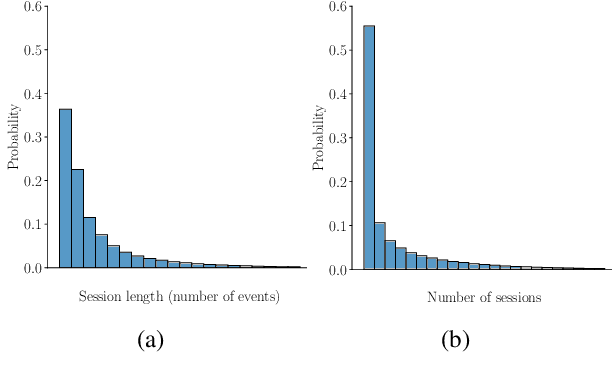

Abstract:This pilot study explores the application of language models (LMs) to model game event sequences, treating them as a customized natural language. We investigate a popular mobile game, transforming raw event data into textual sequences and pretraining a Longformer model on this data. Our approach captures the rich and nuanced interactions within game sessions, effectively identifying meaningful player segments. The results demonstrate the potential of self-supervised LMs in enhancing game design and personalization without relying on ground-truth labels.
MMed-RAG: Versatile Multimodal RAG System for Medical Vision Language Models
Oct 16, 2024Abstract:Artificial Intelligence (AI) has demonstrated significant potential in healthcare, particularly in disease diagnosis and treatment planning. Recent progress in Medical Large Vision-Language Models (Med-LVLMs) has opened up new possibilities for interactive diagnostic tools. However, these models often suffer from factual hallucination, which can lead to incorrect diagnoses. Fine-tuning and retrieval-augmented generation (RAG) have emerged as methods to address these issues. However, the amount of high-quality data and distribution shifts between training data and deployment data limit the application of fine-tuning methods. Although RAG is lightweight and effective, existing RAG-based approaches are not sufficiently general to different medical domains and can potentially cause misalignment issues, both between modalities and between the model and the ground truth. In this paper, we propose a versatile multimodal RAG system, MMed-RAG, designed to enhance the factuality of Med-LVLMs. Our approach introduces a domain-aware retrieval mechanism, an adaptive retrieved contexts selection method, and a provable RAG-based preference fine-tuning strategy. These innovations make the RAG process sufficiently general and reliable, significantly improving alignment when introducing retrieved contexts. Experimental results across five medical datasets (involving radiology, ophthalmology, pathology) on medical VQA and report generation demonstrate that MMed-RAG can achieve an average improvement of 43.8% in the factual accuracy of Med-LVLMs. Our data and code are available in https://github.com/richard-peng-xia/MMed-RAG.
player2vec: A Language Modeling Approach to Understand Player Behavior in Games
Apr 08, 2024Abstract:Methods for learning latent user representations from historical behavior logs have gained traction for recommendation tasks in e-commerce, content streaming, and other settings. However, this area still remains relatively underexplored in video and mobile gaming contexts. In this work, we present a novel method for overcoming this limitation by extending a long-range Transformer model from the natural language processing domain to player behavior data. We discuss specifics of behavior tracking in games and propose preprocessing and tokenization approaches by viewing in-game events in an analogous way to words in sentences, thus enabling learning player representations in a self-supervised manner in the absence of ground-truth annotations. We experimentally demonstrate the efficacy of the proposed approach in fitting the distribution of behavior events by evaluating intrinsic language modeling metrics. Furthermore, we qualitatively analyze the emerging structure of the learned embedding space and show its value for generating insights into behavior patterns to inform downstream applications.
Accelerate Model Parallel Training by Using Efficient Graph Traversal Order in Device Placement
Jan 21, 2022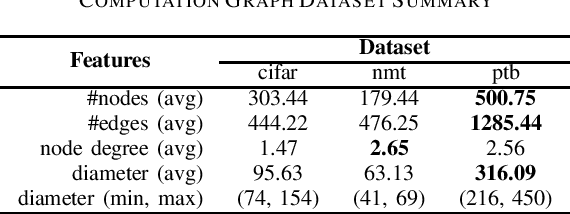
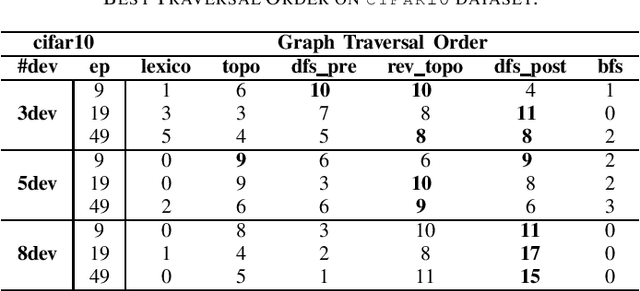
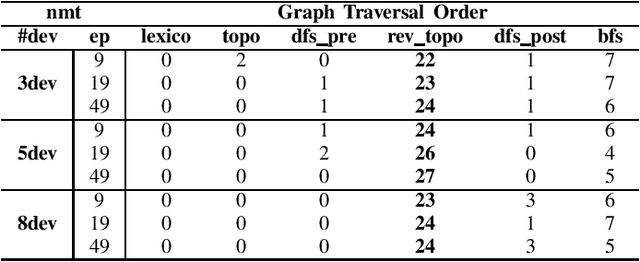
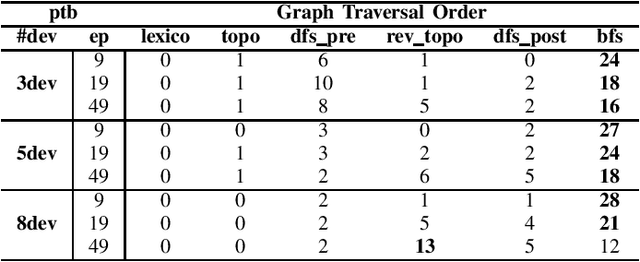
Abstract:Modern neural networks require long training to reach decent performance on massive datasets. One common approach to speed up training is model parallelization, where large neural networks are split across multiple devices. However, different device placements of the same neural network lead to different training times. Most of the existing device placement solutions treat the problem as sequential decision-making by traversing neural network graphs and assigning their neurons to different devices. This work studies the impact of graph traversal order on device placement. In particular, we empirically study how different graph traversal order leads to different device placement, which in turn affects the training execution time. Our experiment results show that the best graph traversal order depends on the type of neural networks and their computation graphs features. In this work, we also provide recommendations on choosing graph traversal order in device placement for various neural network families to improve the training time in model parallelization.
 Add to Chrome
Add to Chrome Add to Firefox
Add to Firefox Add to Edge
Add to Edge